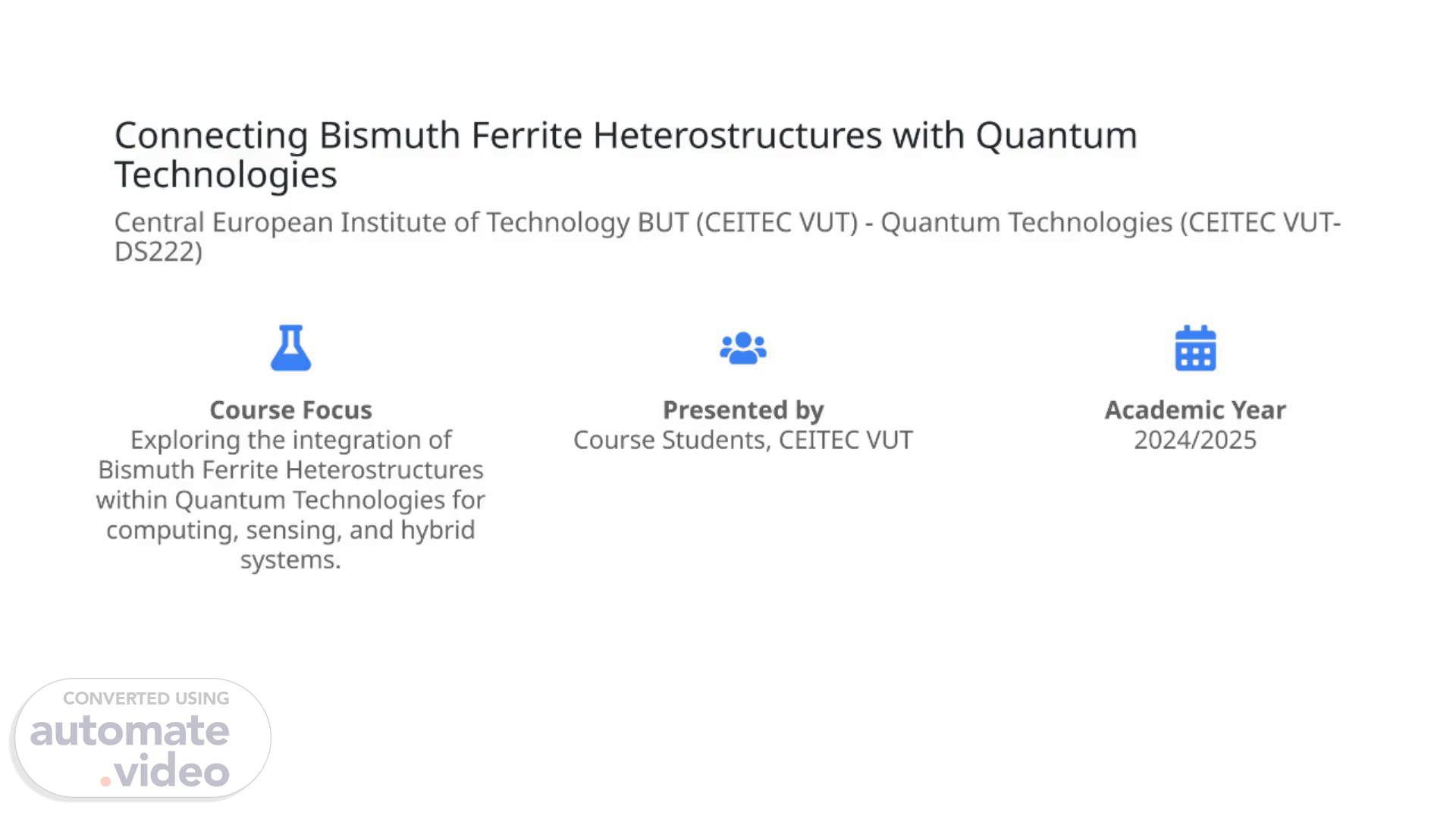Scene 1 (0s)
[Virtual Presenter] Welcome to this presentation, where we delve into the fascinating intersection of Bismuth Ferrite Heterostructures and their applications within Quantum Technologies. This journey takes us through innovative applications in quantum computing, sensing, and hybrid systems - leveraging unique material properties to advance quantum science and technologies. Presented within the context of the Quantum Technologies course (CEITEC VUT-DS222), this discussion reflects ongoing research and collaboration across our institution..
Scene 2 (38s)
[Audio] This presentation explores the applications of Bismuth Ferrite Heterostructures in Quantum Technologies. The table of contents outlines our journey: beginning with an overview of BiFeO₃ properties, moving into quantum phenomena, applications in quantum computing, its role in sensing technologies, and integration within quantum-classical systems. Each topic aims to deepen our understanding of BiFeO₃'s impact on next-generation quantum devices..
Scene 3 (1m 7s)
[Audio] In this section, we explore the foundational properties of Bismuth Ferrite (BiFeO₃), a key multiferroic material known for exhibiting both ferroelectric and antiferromagnetic properties at room temperature. Its perovskite structure provides a versatile platform for creating heterostructures with other materials, thereby enhancing its electronic and magnetic characteristics. These heterostructures are critical for a range of quantum technologies due to their tunable functionality and unique properties..
Scene 4 (1m 41s)
[Audio] Bismuth Ferrite (BiFeO₃) offers unique quantum phenomena that make it invaluable for advanced technological applications. One key feature is its role in spintronics, where its ability to control magnetism through electric fields opens new possibilities for quantum information processing and data storage. Additionally, the strong magnetoelectric coupling in BiFeO₃ allows for precise manipulation of magnetic states with electric fields, a property essential for next-generation quantum devices. Furthermore, its conductive domain walls provide nanoscale channels for charge transport, offering promising capabilities for energy-efficient memory and quantum computing elements..
Scene 5 (2m 24s)
[Audio] Bismuth Ferrite (BiFeO₃) heterostructures hold tremendous potential within quantum computing. By serving as robust qubits, these heterostructures can enhance coherence times, reducing decoherence effects that often hinder quantum performance. In addition, BiFeO₃ enables the implementation of high-fidelity quantum gates, ensuring precision and reliability in quantum computations. The seamless integration of these heterostructures into existing platforms paves the way for hybrid quantum-classical systems, leveraging BiFeO₃'s unique properties for optimized performance across multiple computing paradigms..
Scene 6 (3m 7s)
[Audio] Bismuth Ferrite (BiFeO₃) plays a pivotal role in advancing quantum sensors through its unique material properties. It enables the detection of minute magnetic fields, significantly enhancing the sensitivity of quantum sensors. Furthermore, its ferroelectric behavior allows precise measurement of electric field variations, making it invaluable for high-precision metrology. The temperature stability of BiFeO₃ ensures that its sensing capabilities are retained across a wide range of operating conditions, providing robust performance in various applications, from environmental sensing to medical diagnostics..
Scene 7 (3m 47s)
[Audio] The integration of quantum components into classical computing systems is a critical step towards practical quantum technologies, and Bismuth Ferrite (BiFeO₃) heterostructures are playing a transformative role in this endeavor. BiFeO₃'s unique properties facilitate seamless integration between quantum components and classical electronics, allowing for efficient hybrid systems. Its multifunctional capabilities provide precise interfacing between qubits and classical control mechanisms. Moreover, BiFeO₃'s compatibility with existing fabrication techniques ensures that such systems can be scaled up effectively, paving the way for broader adoption and development of hybrid devices..
Scene 8 (4m 31s)
[Audio] Looking ahead, the future of Bismuth Ferrite (BiFeO₃) heterostructures in quantum technologies appears promising. Researchers continue to refine and optimize BiFeO₃ for robust quantum computing applications, pushing the boundaries of coherence times and qubit performance. In the field of quantum sensing, efforts are directed towards developing BiFeO₃-based sensors with even greater sensitivity and specificity, paving the way for advancements in precision measurements, environmental sensing, and more. Furthermore, ongoing innovations in material engineering, such as doping and strain application, offer opportunities to fine-tune BiFeO₃ properties to meet the demands of emerging quantum technologies..
Scene 9 (5m 19s)
[Audio] To conclude, Bismuth Ferrite (BiFeO₃) heterostructures have demonstrated remarkable versatility, with unique properties such as multiferroicity making them critical for various quantum technologies. BiFeO₃'s applications in quantum computing include the development of robust qubits, precise quantum gate operations, and its integration into hybrid quantum-classical systems. Moreover, its capabilities in quantum sensing, through the detection of minute magnetic and electric fields, offer transformative potential across numerous fields, from precision measurement to medical diagnostics. As research continues to evolve, BiFeO₃ remains a cornerstone of the quantum technology landscape..
Scene 10 (6m 8s)
[Audio] This slide compiles the references utilized throughout this presentation, providing the academic and research context underpinning our exploration of Bismuth Ferrite (BiFeO₃) and its role in quantum technologies. These sources reflect leading-edge research and foundational works in the field, spanning materials science, multiferroics, and quantum applications..
Scene 11 (6m 32s)
[Audio] This presentation would not have been possible without the guidance of Dr. [Instructor's Name] and the collaborative efforts of colleagues and research groups within the Central European Institute of Technology BUT (CEITEC VUT). Our work has also been supported by various funding agencies, making it possible to explore the intersection of Bismuth Ferrite heterostructures and quantum technologies..
